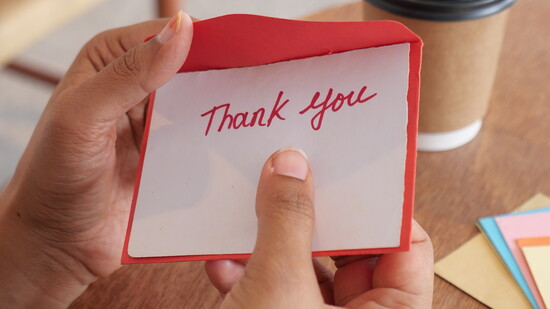Thank you cards can feel like a lost art, but expressing thanks is an essential courtesy that acknowledges another person’s effort and thoughtfulness. By recognizing someone's generosity, you are encouraging a spirit of kindness while demonstrating grace and emotional intelligence.
A verbal thank you is appropriate to acknowledge a small kindness and to show immediate appreciation, but, oftentimes, a written thank you is expected for gifts (both physical and as hospitality), formal occasions, in professional settings, and after any major favor. Sometimes this means you will need to provide a verbal thank you and then follow up with a written thank you card.
A simple “thank you” can sometimes come across as forced, automatic, or insincere. To guarantee that your sincerity is conveyed and understood, one should practice “thank you and…” Thank you and… is the idea that by including a specific detail of enjoyment you are showing that you are attentive, personally impacted by their effort, and truly appreciative of what was offered.
Thank you for the dinner invitation, those potatoes were delicious.
Thank you for the sweater, it is going to look so cute with my brown boots.
When it is time to write a thank you card, keep in mind that there are six parts to a well-constructed thank you note.
- To begin, date your note and write a greeting: ”November 12, 2025, Dear so-and-so,"
- Express your thanks clearly and specifically: "Thank you for my birthday gift. I appreciate your assistance with my project last week."
- Add a personal touch or provide details. This is where you explain why the gift means so much to you or how it helped you: "Your advice was very insightful. I now feel confident in my college choice," or "The book you chose was so heartwarming."
- Share your desire to reconnect. While this step is technically optional, mentioning future interactions can reinforce a relationship and comes across as thoughtful: "Let’s plan to meet for lunch next month," or "I’m looking forward to working with you again soon."
- Restate your thanks once more time: "I am truly grateful for your support." or "Thank you again for your kind generosity."
- Finish with a sendoff, such as "Kind regards," or "Sincerely,"
When you are writing a thank you note, only tell the truth, but focus on the positive. That new purse might just be the most hideous shade of orange you have ever seen, but you don’t have to share that thought! Your grandmother still spent her time and money selecting a gift for you and showing her affection. That is worth a thank you!
In every setting, gratitude is most meaningful when it is genuine, thoughtful, and timely. A thank-you does not need to be long or elaborate to be effective. What matters most is sincerity and attention to detail. If you consistently express gratitude — both in words and in writing — you will stand out for leaving others feeling truly valued.
Amanda Wagner directs the Greater Kansas City Chapter of Junior Cotillion, teaching etiquette and leadership to youth. Learn more or get involved at www.KCcotillion.com or email Amanda.Wagner@nljc.com
When you are writing a thank you note, only tell the truth, but focus on the positive.
